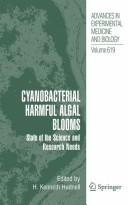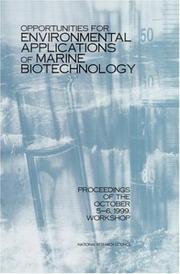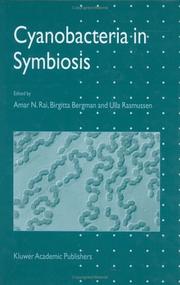| Listing 1 - 10 of 16 | << page >> |
Sort by
|
Book
ISBN: 9783038421566 Year: 2016 Publisher: [Place of publication not identified] : Multidisciplinary Digital Publishing Institute,
Abstract | Keywords | Export | Availability | Bookmark
 Loading...
Loading...Choose an application
- Reference Manager
- EndNote
- RefWorks (Direct export to RefWorks)
Annotation Over the past decade, coastal and freshwater systems in the U.S. and worldwide have experienced an apparent increase in the frequency and geographic distribution of harmful algal blooms (HABs). These blooms can adversely affect both public health and ecosystem health. Toxin-producing HABs can accumulate in drinking and recreational waters and in foods of aquatic origin such as fish and seafood. Human and animal health risks include exposure to the toxins through eating contaminated food or drinking or swimming in contaminated water. Because of these potential public health risks, several countries and U.S. states have developed monitoring programs and guidelines for drinking and recreational water quality to protect public health. This special issue will present research papers and reviews on various aspects of public health and environmental responses to harmful algal blooms. The subthemes considered include: - HAB monitoring for public health protection and response - Public health surveillance for HAB-related exposures and illnesses - Health risks from exposure to contaminated fish and shellfish, drinking and recreational water - Remediation and treatment technologies - Challenges and successes of HAB-related public health education campaigns and programs - HAB risk management.
Algal blooms. --- Algae blooms --- Blooms, Algal --- Microalgal blooms --- Phytoplankton algal blooms --- Water bloom --- Water blooms --- Algal populations --- Microalgae --- Plankton blooms
Book
ISBN: 3038421561 Year: 2016 Publisher: Basel, Switzerland : MDPI,
Abstract | Keywords | Export | Availability | Bookmark
 Loading...
Loading...Choose an application
- Reference Manager
- EndNote
- RefWorks (Direct export to RefWorks)
Over the past decade, coastal and freshwater systems in the U.S. and worldwide have experienced an apparent increase in the frequency and geographic distribution of harmful algal blooms (HABs). These blooms can adversely affect both public health and ecosystem health. Toxin-producing HABs can accumulate in drinking and recreational waters and in foods of aquatic origin such as fish and seafood. Human and animal health risks include exposure to the toxins through eating contaminated food or drinking or swimming in contaminated water. Because of these potential public health risks, several countries and U.S. states have developed monitoring programs and guidelines for drinking and recreational water quality to protect public health. This special issue will present research papers and reviews on various aspects of public health and environmental responses to harmful algal blooms. The subthemes considered include: - HAB monitoring for public health protection and response - Public health surveillance for HAB-related exposures and illnesses - Health risks from exposure to contaminated fish and shellfish, drinking and recreational water - Remediation and treatment technologies - Challenges and successes of HAB-related public health education campaigns and programs - HAB risk management.
Algal blooms. --- Algae blooms --- Blooms, Algal --- Microalgal blooms --- Phytoplankton algal blooms --- Water bloom --- Water blooms --- Algal populations --- Microalgae --- Plankton blooms
Book
ISBN: 1614702101 9781614702108 9781607418382 160741838X Year: 2010 Publisher: New York
Abstract | Keywords | Export | Availability | Bookmark
 Loading...
Loading...Choose an application
- Reference Manager
- EndNote
- RefWorks (Direct export to RefWorks)
Algal blooms --- Algae blooms --- Blooms, Algal --- Microalgal blooms --- Phytoplankton algal blooms --- Water bloom --- Water blooms --- Algal populations --- Microalgae --- Plankton blooms --- Health aspects. --- Environmental aspects. --- Research
Book
ISBN: 1634854004 9781634854009 1634853997 9781634853996 Year: 2016 Publisher: New York
Abstract | Keywords | Export | Availability | Bookmark
 Loading...
Loading...Choose an application
- Reference Manager
- EndNote
- RefWorks (Direct export to RefWorks)
Algal blooms --- Algae blooms --- Blooms, Algal --- Microalgal blooms --- Phytoplankton algal blooms --- Water bloom --- Water blooms --- Algal populations --- Microalgae --- Plankton blooms --- Research --- Planning.
Book
ISBN: 1003081444 9781003081449 9781000262049 1000262049 9781000262032 1000262030 9781000262025 1000262022 9780367533311 0367533316 0367533324 Year: 2021 Publisher: Boca Raton : CRC Press,
Abstract | Keywords | Export | Availability | Bookmark
 Loading...
Loading...Choose an application
- Reference Manager
- EndNote
- RefWorks (Direct export to RefWorks)
Protecting drinking, recreational, and other water from toxic cyanobacteria has a major impact on health. This new edition outlines water-related exposure pathways, supports hazard analysis and risk assessment, and outlines strategies for their control and the design and implementation of monitoring programmes.
Plankton blooms. --- Drinking water Microbiology. --- Blooms, Plankton --- Water bloom --- Water blooms --- Plankton populations --- Cyanobacteria. --- Bacteria, Blue-green --- Blue-green algae --- Blue-green bacteria --- Blue-greens (Microorganisms) --- Cryptophyceae --- Cyanochloronta --- Cyanophyceae --- Cyanophycota --- Cyanophyta --- Myxophyceae --- Myxophyta --- Phycochromophyceae --- Schizophyceae --- Prokaryotes

ISBN: 1281242306 9786611242305 0387758658 038775864X Year: 2008 Publisher: New York : Springer,
Abstract | Keywords | Export | Availability | Bookmark
 Loading...
Loading...Choose an application
- Reference Manager
- EndNote
- RefWorks (Direct export to RefWorks)
Cyanobacteria are single-celled organisms that live in fresh, brackish, and marine water. They use sunlight to make their own food. In warm, nutrient-rich environments, microscopic cyanobacteria can grow quickly, creating blooms that spread across the water’s surface and may become visible. Because of the color, texture, and location of these blooms, the common name for cyanobacteria is blue-green algae. However, cyanobacteria are related more closely to bacteria than to algae. Cyanobacteria are found worldwide, from Brazil to China, Australia to the United States. In warmer climates, these organisms can grow year-round. Scientists have called cyanobacteria the origin of plants, and have credited cyanobacteria with providing nitrogen fertilizer for rice and beans. But blooms of cyanobacteria are not always helpful. When these blooms become harmful to the environment, animals, and humans, scientists call them cyanobacterial harmful algal blooms (CyanoHABs). Freshwater CyanoHABs can use up the oxygen and block the sunlight that other organisms need to live. They also can produce powerful toxins that affect the brain and liver of animals and humans. Because of concerns about CyanoHABs, which can grow in drinking water and recreational water, the U.S. Environmental Protection Agency (EPA) has added cyanobacteria to its Drinking Water Contaminant Candidate List. This list identifies organisms and toxins that EPA considers to be priorities for investigation. Reports of poisonings associated with CyanoHABs date back to the late 1800's. Anecdotal evidence and data from laboratory animal research suggest that cyanobacterial toxins can cause a range of adverse human health effects, yet few studies have explored the links between CyanoHABs and human health. Humans can be exposed to cyanobacterial toxins by drinking water that contains the toxins, swimming in water that contains high concentrations of cyanobacterial cells, or breathing air that contains cyanobacterial cells or toxins (while watering a lawn with contaminated water, for example). Health effects associated with exposure to high concentrations of cyanobacterial toxins include: stomach and intestinal illness; trouble breathing; allergic responses; skin irritation; liver damage; and neurotoxic reactions, such as tingling fingers and toes. Scientists are exploring the human health effects associated with long-term exposure to low levels of cyanobacterial toxins. Some studies have suggested that such exposure could be associated with chronic illnesses, such as liver cancer and digestive-system cancer. This monograph contains the proceedings of the International Symposium on Cyanobacterial Harmful Algal Blooms held in Research Triangle Park, NC, September 6-10, 2005. The symposium was held to help meet the mandates of the Harmful Algal Bloom and Hypoxia Research and Control Act, as reauthorized and expanded in December 2004. The monograph will be presented to Congress by an interagency task force. The monograph includes: 1) A synopsis which proposes a National Research Plan for Cyanobacteria and their Toxins; 2) Six workgroup reports that identify and prioritize research needs; 3) Twenty-five invited speaker papers that describe the state of the science; 4) Forty poster abstracts that describe novel research.
Algal blooms --- Cyanobacterial blooms --- Cyanobacterial toxins --- Health aspects. --- Prevention. --- Environmental aspects. --- Algae blooms --- Blooms, Algal --- Microalgal blooms --- Phytoplankton algal blooms --- Water bloom --- Water blooms --- Algal populations --- Microalgae --- Plankton blooms --- Blue-green algal toxins --- Cyanobacteria toxins --- Cyanotoxins --- Bacterial toxins --- Blooms, Cyanobacterial --- Cyanobacteria blooms --- Cyanobacteria --- Neurosciences. --- Neural sciences --- Neurological sciences --- Neuroscience --- Medical sciences --- Nervous system

ISBN: 0309071887 0309501644 9780309071888 9780309501644 0305071887 0309171466 Year: 2000 Publisher: Washington, D.C. : National Academy Press,
Abstract | Keywords | Export | Availability | Bookmark
 Loading...
Loading...Choose an application
- Reference Manager
- EndNote
- RefWorks (Direct export to RefWorks)
Algal blooms -- Congresses. --- Electronic books. -- local. --- Marine biotechnology -- Congresses. --- Marine biotechnology --- Bioremediation --- Mechanical Engineering --- Engineering & Applied Sciences --- Bioengineering --- Algal blooms --- Algae blooms --- Blooms, Algal --- Microalgal blooms --- Phytoplankton algal blooms --- Water bloom --- Water blooms --- Algal populations --- Microalgae --- Plankton blooms --- Biotechnology --- Marine biology

ISBN: 1402007779 0306480050 9781402007774 Year: 2002 Publisher: Dordrecht : Springer Netherlands,
Abstract | Keywords | Export | Availability | Bookmark
 Loading...
Loading...Choose an application
- Reference Manager
- EndNote
- RefWorks (Direct export to RefWorks)
Cyanobacterial symbioses are no longer regarded as mere oddities but as important components of the biosphere, occurring both in terrestrial and aquatic habitats worldwide. It is becoming apparent that they can enter into symbiosis with a wider variety of organisms than hitherto known, and there are many more still to be discovered, particularly in marine environments. The chapters cover cyanobacterial symbioses with plants (algae, bryophytes, Azolla, cycads, Gunnera), cyanobacterial symbioses in marine environments, lichens, Nostoc-Geosiphon (a fungus closely related to arbuscular mycorrhiza fungi) symbiosis, and artificial associations of cyanobacteria with economically important plants. In addition, cyanobiont diversity, sensing-signalling, and evolutionary aspects of the symbiosis are dealt with. Renowned experts actively involved in research on cyanobacterial symbioses deal with ecological, physiological, biochemical, molecular, and applied aspects of all known cyanobacterial symbioses. This volume on cyanobacteria in symbiosis complements the two earlier volumes on cyanobacteria published by Kluwer (Molecular Biology of Cyanobacteria, edited by D.A. Bryant and Ecology of Cyanobacteria, edited by B.A. Whitton and M. Potts). Together, the three volumes provide the most comprehensive treatment of cyanobacterial literature as a whole. The book will serve as a valuable reference work and text for teaching and research in the field of plant-microbe interactions and nitrogen fixation.
Cyanobacterial blooms. --- Cyanobacteria --- Symbiosis. --- Symbiosis --- Ecology. --- Ecology --- Cyanobacterial blooms --- Biology --- Health & Biological Sciences --- Microbiology & Immunology --- Consortism --- Symbiogenesis --- Bacteria, Blue-green --- Blue-green algae --- Blue-green bacteria --- Blue-greens (Microorganisms) --- Cryptophyceae --- Cyanochloronta --- Cyanophyceae --- Cyanophycota --- Cyanophyta --- Myxophyceae --- Myxophyta --- Phycochromophyceae --- Schizophyceae --- Prokaryotes --- Blooms, Cyanobacterial --- Cyanobacteria blooms --- Water bloom --- Water blooms --- Plankton blooms --- Cyanobacteria - Ecology. --- Cyanobacteria - Ecology
Book
ISBN: 9780813175607 0813175607 9780813175614 0813175615 9780813175591 0813175593 Year: 2018 Publisher: Lexington, Kentucky
Abstract | Keywords | Export | Availability | Bookmark
 Loading...
Loading...Choose an application
- Reference Manager
- EndNote
- RefWorks (Direct export to RefWorks)
Algal blooms. --- Cyanobacteria --- Cyanobacteria. --- Bacteria, Blue-green --- Blue-green algae --- Blue-green bacteria --- Blue-greens (Microorganisms) --- Cryptophyceae --- Cyanochloronta --- Cyanophyceae --- Cyanophycota --- Cyanophyta --- Myxophyceae --- Myxophyta --- Phycochromophyceae --- Schizophyceae --- Prokaryotes --- Algae blooms --- Blooms, Algal --- Microalgal blooms --- Phytoplankton algal blooms --- Water bloom --- Water blooms --- Algal populations --- Microalgae --- Plankton blooms --- Toxicology.
Periodical
Abstract | Keywords | Export | Availability | Bookmark
 Loading...
Loading...Choose an application
- Reference Manager
- EndNote
- RefWorks (Direct export to RefWorks)
Toxic algae --- Microalgae --- Cyanobacteria --- Algal blooms --- Monitoring --- Control --- Algae blooms --- Blooms, Algal --- Microalgal blooms --- Phytoplankton algal blooms --- Water bloom --- Water blooms --- Bacteria, Blue-green --- Blue-green algae --- Blue-green bacteria --- Blue-greens (Microorganisms) --- Cryptophyceae --- Cyanochloronta --- Cyanophyceae --- Cyanophycota --- Cyanophyta --- Myxophyceae --- Myxophyta --- Phycochromophyceae --- Schizophyceae --- Micro-algae --- Algal blooms. --- Cyanobacteria. --- Microalgae. --- Toxic algae. --- Monitoring. --- Control. --- Monitoring of algal blooms --- Algae --- Poisonous plants --- Microorganisms --- Prokaryotes --- Environmental monitoring --- Algal populations --- Plankton blooms --- Fungi & Algae --- Algues toxiques --- Microalgues --- Cyanobactéries --- Poussées phytoplanctoniques
| Listing 1 - 10 of 16 | << page >> |
Sort by
|

 Search
Search Feedback
Feedback About UniCat
About UniCat  Help
Help News
News